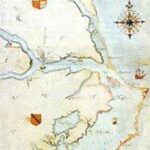Imagine returning to the location of what had previously been a burgeoning colony of over 100 settlers only to find the village abandoned with no trace of the occupants. This is what happened to John White at Roanoke Island. The circumstances surrounding the disappearance of the Roanoke Colony is one of the biggest mysteries in American history.
By 1587, England and its European rivals had been crossing the Atlantic Ocean to explore the New World for over 50 years. Queen Elizabeth I realized that whichever nation was able to gain a permanent foothold in those lands would have a substantial advantage over its rivals. As a result, she commissioned Sir Walter Raleigh to put together a group of settlers to stake out a claim to land in North America.
Raleigh first sent out a group in July of 1585 to accomplish the Queen’s wish. This expedition was almost entirely composed of soldiers, with a few specialists. Upon reaching the New World, the group decided that Roanoke Island looked like a hospitable place to live. Unfortunately, these men, although brave, were ill equipped to handle the task of surviving in a new land. A year after the group had been dropped off, the English explorer Sir Francis Drake decided to stop by the colony to check on its progress. What he found was a starving collection of pathetic individuals who had gotten into the bad graces of the local Indian tribes by killing one of their chiefs. Drake rescued the bedraggled settlers and returned them to England.
The first attempt to put a permanent British settlement in North America had failed, but Raleigh was far from ready to give up. He put John White, who had been one of the specialists on the first colonization attempt, in charge of forming a new group to return to America.
White felt that one of the reasons that the first attempt to settle had failed was because the men involved were just there to do a job and were not fully invested in the outcome. To solve this problem, he thought the best thing to do was put together a settlement team made up of families. He would give each family 500 acres of land to live on permanently and a say in the governance of the colony. It was difficult to find men willing to subject their families to the hardships of colonizing a new land, but by 1587, White had gathered an acceptable mix of people. They began their transatlantic crossing in the spring with 91 men, 17 women and 9 children.
It had been decided that Roanoke Island was not an ideal location for growing crops, so the expedition set out with the goal of landing north of Roanoke, around Chesapeake Bay. Unfortunately, there was some communication failure between those who made that decision and the captain of the boat, because he brought the settlers back to Roanoke Island claiming that nobody had told him to bring them elsewhere. Despite protestations from White, the captain insisted that they all must debark at Roanoke.
Trying to make the best of a difficult situation, White had the group repair the fort and houses that already existed from the prior expedition. The small advantage of existing structures wasn’t to be enough to make the colony a success. It turned out that the colonial planners had been correct when they decided that Roanoke should not be settled again. There were not going to be enough supplies to sustain the colony over the long term in that location.
The ships that transported the group from Europe were still anchored offshore, waiting for the proper wind conditions to return home. John White was chosen by the settlers to return to England with the boats and come back with what they needed. On August 27, 1587, White set sail. He left behind not just a group of colonists he had organized, but also his daughter and newly born grandchild. He expected to return the following spring. That would prove impossible.
Shortly after White returned to England, the Spanish Armada arrived in an attempt to conquer England. Queen Elizabeth needed all the ships and men she could muster to defend the homeland and wouldn’t let White sail back to America. Even after the Armada was defeated, Elizabeth wanted to keep her ships nearby in case the Spanish attempted a second attack. As a result, it was three years before White was able to return to Roanoke.
When White finally landed on Roanoke Island, there was nobody there. The only evidence as to where the group might have gone were the letters “C-R-O” carved into one tree and “Croatoan” inscribed on another tree. Before he left for England, White and the settlers had discussed the possibility that circumstances might force relocation north toward the Chesapeake Bay area they had originally intended to colonize. If they were going to do this, the plan was to carve their destination into a tree. If they were forced to move because they were in some kind of danger, a cross was to be carved into the same tree. Since there was no cross to be found on either of the trees with writing on it, White was left to assume that the move was voluntary.
Croatoan Island was south of Roanoke, but based on the tree carvings, this was the only place White could infer they had gone. He prepared to set sail for the island but again fate stood in his way. Hurricane season was fast approaching and extremely strong winds made it too dangerous for ships to stay anchored close to shore. White was forced to return with his men to England.
John White was never able to return to the New World again to search for his family and the other settlers. Future expeditions were also unsuccessful in finding the “Lost Colony.”
Why would the residents of Roanoke Island leave voluntarily when they knew that John White would be returning to their original location with supplies? Why would they move south when the plan had been that, if they were to move at all, they would move north? How could a group of 117 settlers seemingly disappear into thin air? These are the mysteries of the Roanoke Island colony and they are unlikely to ever be solved.






